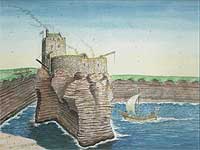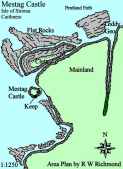| Mestag Castle, Island of Stroma, Caithness Map Ref: ND 339763 Landranger Sheet 12 Mestag Photo Gallery From The Air
Introduction The small Island of Stroma lies about 2 miles off the mainland to the North of Gills Bay about midway between St John's Point and Duncansby Head. It no doubt has a long, but mostly unrecorded history. It was known in the Sagas as Straumey or Staumsey meaning "the island in the current" or "the island in the stream" and would have been a welcome refuge to take shelter from the notorious maelstrom of the Pentland Firth. It would also have provided a strategic base for Viking raiders and pirates. It comes as little surprise therefore to find that there were at least two Castles on the Island, one called "Flendie Clett" at Scarton Point, to the South East of the Island and another called "Mestag" near Mell Head in the South West corner. There is also a Fortified Promontory called "Bught o' Camm" on the West side of the Island. All three have strong Viking connections. We shall deal with "Flendie Clett" and "Bught O' Camm" separately at a later date.
The Sinclairs, upon their accession to the Earldom of Caithness, soon obtained ownership of Stroma and it was subsequently granted to William Sinclair in 1574, a brother of George Sinclair of Mey and then by John Kennedy of Kairnmuck, Aberdeenshire in 1659. It seems to have reverted to Sinclair ownership again in the early 1700's who then held it for a further 200 years. Other than a period of ownership by the Sinclairs and probably Sweyn the Pirate, little else is known of the history of the castle so far. A reference written in 1879 however states:- "A large precipitous rock, separated from the Island by a deep narrow gully about 20 ft wide. Ruins of a house are still visible. The house or castle, tradition says, was at one time occupied by a robber (name unknown) who used to cross to the island by means of a drawbridge, and help himself to any cattle or sheep he happened to meet and then retire to his castle and draw up the bridge." References:
Also See: |

